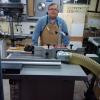My shop is in my basement, which means it's mostly comprised of cement walls, and one of those walls has cabinets hanging up on it. These are cabinets I built over 10 years ago, and they are just big, deep, open, plywood cabinets. Their design and height off the floor means that accessing items in them is actually quite annoying. I want to take them down and turn that wall into a french cleat storage wall instead.
My question is whether I should just mount the cleats directly to the cement wall, or should I build a sub-wall out of plywood and furring strips and then mount the cleats to that. Mounting the cleats directly means it's less work for me overall, but having a plywood wall means I have the option of attaching things directly to the plywood if desired.
Suggestions?
Thanks,
Steve





 Reply With Quote
Reply With Quote




 Unless you're a fan of "free form" storage with stuff on nails, etc., I wouldn't' bother with the plywood for cost reasons, honestly.
Unless you're a fan of "free form" storage with stuff on nails, etc., I wouldn't' bother with the plywood for cost reasons, honestly.
